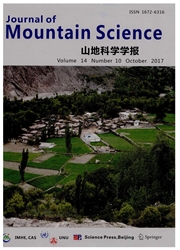

 中文摘要:
中文摘要:
这份报纸在中国在 Hengduan 山分析差异和高度的带的空间模式。基础带的 7 种类型和高度的带的 26 种类型的一个总数在学习区域被识别。主要高度的环城线例如森林线,黑暗具球果的森林和雪线的上面的限制,也就是,类似的纬度、纵的空间模式与纬度和凹面拱了二次的曲线模型二次的曲线模型纵的方向。这些模式能在一起作为鈥淗y perbolic 抛物面模型鈥打电话吗?在学习区域揭示环境和生态学的复杂性和专业。这结果进一步为高度的带由作者建议了的山的空间模式验证一个普通二次的模型的催眠状态。高度的带的空间模式仔细在 Hengduan 山与潮湿相关的暴露效果被联系。高度的带和不同的基础带类型的不同联合(系列) 出现在上风并且下风胁腹并且甚至在不同范围的一样的胁腹。这仔细与 Hengduan 山的平行山脉被联系,它,在将近,有占优势的潮湿沉重的空气的动人的方向的直角从西方和东方集中,从搬到不同潮湿条件进核心区域和结果举起温暖、潮湿的季风风上风并且下风胁腹。然而,怎么描述潮湿相关的暴露效果到份量上,需要进一步的学习。另外,数据质量和数据精确性也目前影响量的建模的结果到某程度并且以后应该与 RS/GIS 被改进。关键词 Hengduan 山 - 高度的带系列 - 暴露效果 - 二次的模型
 英文摘要:
英文摘要:
This paper analyses the diversity and spatial pattern of the altitudinal belts in the Hengduan Mountains in China. A total of 7 types of base belts and 26 types of altitudinal belts are identified in the study region. The main altitudinal belt lines, such as forest line, the upper limit of dark coniferous forest and snow line, have similar latitudinal and longitudinal spatial patterns, namely, arched quadratic curve model with latitudes and concave quadratic curve model along longitudinal direction. These patterns can be together ealled as "Hyperbolic-paraboloid model", revealing the complexity and speciality of the environment and ecology in the study region. This result further validates the hypnosis of a common quadratic model for spatial pattern of mountain altitudinal belts proposed by the authors. The spatial pattern of altitudinal belts is closely related with moisture-related exposure effect in the Hengduan Mountains. Different combinations (spectra) of altitudinal belts and different base belt types appear in windward and leeward flanks and even in the same flanks of different ranges. This is closely related with the parallel mountain ranges of the Hengduan Mountains, which, at nearly right angle with the moving direction of prevailing moisture-laden air masses from west and east, hold up the warm and humid monsoon wind from moving into the core region and result in different moisture conditions in windward and leeward flanks. However, how to quantitatively describe the moisture-related exposure effect needs further study. In addition, the data quality and data accuracy at present also affect to some extent the result of quantitative modeling and should be improved with RS/GIS in the future.
 同期刊论文项目
同期刊论文项目
 同项目期刊论文
同项目期刊论文
 期刊信息
期刊信息
